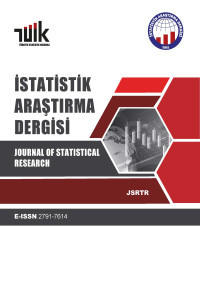Tanı Testlerinin Performanslarının Kullback-Leibler Uzaklığı Yaklaşımı ile Değerlendirilmesi ve Pulmoner Hipertansiyon Verileri ile Bir Uygulama
Doppler ekokardiyografi, İki boyutlu ekokardiyografi, Kullback-Leibler uzaklığı, Pulmoner hipertansiyon, Tanı testleri
Evaluation of Diagnostic Tests Performance by Using Kullback-Leibler Distance Approach and an Application with the Pulmonary Hypertension Data
Doppler echocardiography, Two dimensional echocardiography, K-L distance, Pulmonary hypertension, Diagnostic tests,
___
- Benish, W.A., 1999. Relative Entropy as a Measure of Diagnostic Information. Medical Decision Making. 19(2), 202-6.
- Benish, W.A., 2002. The Use of Information Graphs to Evaluate and Compare Diagnostic Tests. Methods of Information in Medicine, 41(2), 114-8.
- Çiftci, O., 2007. Echocardiographic assessment of right ventricular and right atrial functions in patients with pulmonary hypertension of different etiologies and severities. Hacettepe University Faculty of Medicine, Department of Cardiology. Ankara (in Turkish).
- Dreiseitl, S., Machado, O.L., Binder, M., 2000. Cornparing Three-class Diagnostic Tests by Three-way ROC Analysis. Medical Decision Making, 20(3), 323-331.
- Lee, W.C., 1999. Selecting Diagnostic Tests for Ruling Out or Ruling In Disease: The Use of the Kullback-Leibler Distance. International Journal of Epidemiology, 28(3), 521-5.
- Metz, C.E., Goodenough, D. L ve Rossmann, K., 1973. Evaluation of Receiver Operating Characteristic Curve Data in Terms of Information Theory, with Applications in Radiography. Radiology, 109(2), 297-303.
- Mossman, D., Somoza, E., 1992. Diagnostic Tests and Information Theory. The Journal of Neuropsychiatry and Clinical Neurosciences, 4(1), 95-98.
- Mossman D., 1999. Three-way ROCs. Medical Decision Making, 19(1),78-89.
- Somoza, E., Soutullo-Esperon L., Mossman D., 1989. Evaluation and Optimization of Diagnostic Tests Using Receiver Operating Characteristic Analysis and Information Theory. International Journal of Bio-Medical Computing, 24(3), 153-89.
- Somoza, E., Mossman D., 1991. Neuropsychiatric Decision Making: Designing Nonbinary Diagnostic Tests. The Journal of Neuropsychiatry and Clinical Neurosciences, 3(2), 197-200.
- Somoza, E., Mossman, D., 1992. Comparing and Optimizing Diagnostic Tests: An Information-theoretical Approach. Medical Decision Making, 12(3), 179-188.
- Thomas, J.A., 2001. Elements of Information Theory. John Wiley & Sons, Inc., Publication.
- ISSN: 1303-6319
- Başlangıç: 2002
- Yayıncı: TÜİK
Fatma NOYAN, Gülhayat GÖLBAŞI ŞİMŞEK
Uyarlanabilir Küme Örneklemesinde Ön Örneklem Hacmine Göre Etkinlik
Umut ARSLAN, Ergun KARAAĞAOĞLU, Orçun ÇİFTÇİ, Necla ÖZER, Barış KAYA
Cox Oransal Hazard Regresyon Modeli ve Trafik Verilerine Uygulanması
Filiz KARDİYEN, Gökhan KAYGISIZ
Türkiye İklim Bölgelerinin Hiyerarşik Kümeleme Yöntemi ile Belirlenmesi
Elçin KARTAL, Cem İYİGÜN, Fidan M. FAHMİ, Ceylan YOZGATLIGİL, Vilda PURUTÇUOĞLU, İnci BATMAZ, Gülser KÖKSAL, Murat TÜRKEŞ
